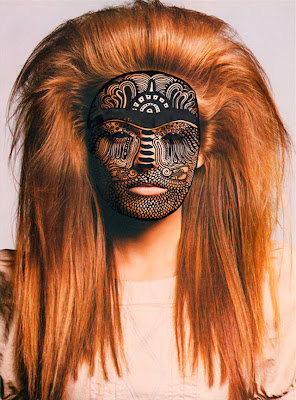So I haven't really looked much into hair yet, so I thought I best have a look!
 |
| Hairstyle from the Mwila Tribe, Taken from http://www.flickr.com/photos/mytripsmypics/5260740241/ |
This Hair style is incredible, it's actually more hair sculpting than a style. The hair is braided into 4 or 5 plaits, sometimes 3 if a family member has died. It is then smothered in a red paste that is made from crushed red stones, oil, cow dung, herbs and and ground down tree bark. When the paste dries it hardens to create the octopus like tentacles above. This hairstyle is traditionally worn by women in the Mwila tribe. The Mwila women shave the front of their hair to create a higher forehead as this is seen as beautiful in their culture. Beads, dried food and shells are added to the hairstyle as decoration.
 |
| Mwila Tribe, Taken from http://thecoincidentaldandy.blogspot.co.uk/ |
The Mwila women wear heavy necklaces, each necklace corresponds to a period in their life. There are different coloured beads for different times in their life, they necklaces can never be taken off, they even have to sleep with them on....ouch!
Take a look at this video where members of the Mwila tribe have their photo taken by a tour operator, it shows many different Mwila tribe hairstyles and dress. Turn your volume down though, its very noisy!
Take a look at this video where members of the Mwila tribe have their photo taken by a tour operator, it shows many different Mwila tribe hairstyles and dress. Turn your volume down though, its very noisy!
 |
| Himba Tribe, Taken from http://www.flickr.com/photos/abgefahren2004/5971003550/ |
This is a girl from the Himba tribe, Namiibia. Children of the Himba tribe wear their hair in 2 plaits and when they hit puberty these plaits are moved towards their face and over thier eyes and they may have more than 2. Once married the Himba women can have many plaits all over their head. If a man in the Himba tribe is single he will wear a single plait down his neck but if he is married his hair will be hidden under a turban. The hair designs are created in much the same way as the Mwila tribe, with a red paste being painted onto the designs, however the Himba tribe don't have any decorations in thier hair. A really like the design above as the hair has taken on the form of curly antlers.
 |
| Himba Tribe, Taken from http://www.flickr.com/photos/julienlagarde/6200550836/ |
This image shows the hairstyle of a married Himba woman. This hairstyle is kind of Medusa-like, I love the wooly tips of each dreadlock, it looks really interesting.
 |
| Surma Tribe, Taken from http://www.flickr.com/photos/abgefahren2004/6354408999/in/photostream/ |
Some tribes shave their hair off, like this girl above from the Surma tribe. During ceremonies people of the Surma tribe decorate themselves with flowers and fruit, creating a kind of headdress.
Trials


























